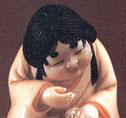Not only are the seven lucky gods very well-known in Japan, but they are also popular as netsuke subjects. However, until several years ago, I had some difficulty identifying which god is which.
One day, my father told me that “Even though similar to Fukurokuju, Jurojin wears a hat.” Then I realized that it’s easy to distinguish the seven gods once I grouped them according to their appearance.
For those who have the same difficulty that I had, here are my tips:
Group 1. Gods wearing a loose kimono-like robe:
Fukurokuju has a long white beard and moustache, as well as a bald and elongated head.
Similar to Fukurokuju, Jurojin has a long white beard and moustache, but he wears a hat.
Sometimes depicted together with a deer.
Hotei wears similar clothing, but reveals a round belly. His beard and moustache are black and short.
Often depicted holding a fan and/or a large bag.
Group 2. Gods wearing a short smock-like garment and puffy trousers:
Daikoku carries a mallet of good fortune.
Sometimes depicted on a straw rice-bag.
Ebisu holds a fish (red-snapper) and a fishing rod.
Group 3. The last two gods are easy to identify:
Bishamonten is clad in armor.
Benten (or Benzaiten) is the only goddess, so her garment and hairstyle are feminine.
That’s all. The main point is whether you can distinguish between Fukurokuju and Jurojin, as well as Daikoku and Ebisu. The rest are relatively easy to identify.
Once you are able to distinguish all of them, I think it becomes easier to remember what else each god holds or is depicted with, as well as the meaning of each god.

I hope this helps!